Dec 21 - Design Notes
Heroes of Adventure » Devlog
Design Notes
- This log details my design decisions and essentially describes my ‘flavour’ of classic fantasy adventuring.
- I have broken this down into a chapter-by-chapter summary which hopefully gives you some insight into the rationale behind my design choices.
Objectives
- Create a simple RPG system we could ‘pick up and play’ online during the times of the pandemic.
- Recreate that feeling of classic fantasy adventuring from yesteryear.
- Develop my desired theme (keywords were; exploration; scavenging; perilous adventuring; grim; gritty; wilderness; borderlands; low magic and weirdness)
- I made a deliberate decision to write everything in bullet point format for conciseness.
- I also encouraged both players and referee to read each chapter so everyone understands the system; processes and world-building elements.
- There is a risk that ‘meta-knowledge’ may negatively impact the game. My perspective is that it creates greater investment in the game and represents an element of ‘player skill’ (knowing things) and can simply be assumed to be common knowledge, lore or rumours in game. It is also mitigated by the fact that the referee is encouraged to customise details and not present everything as read.
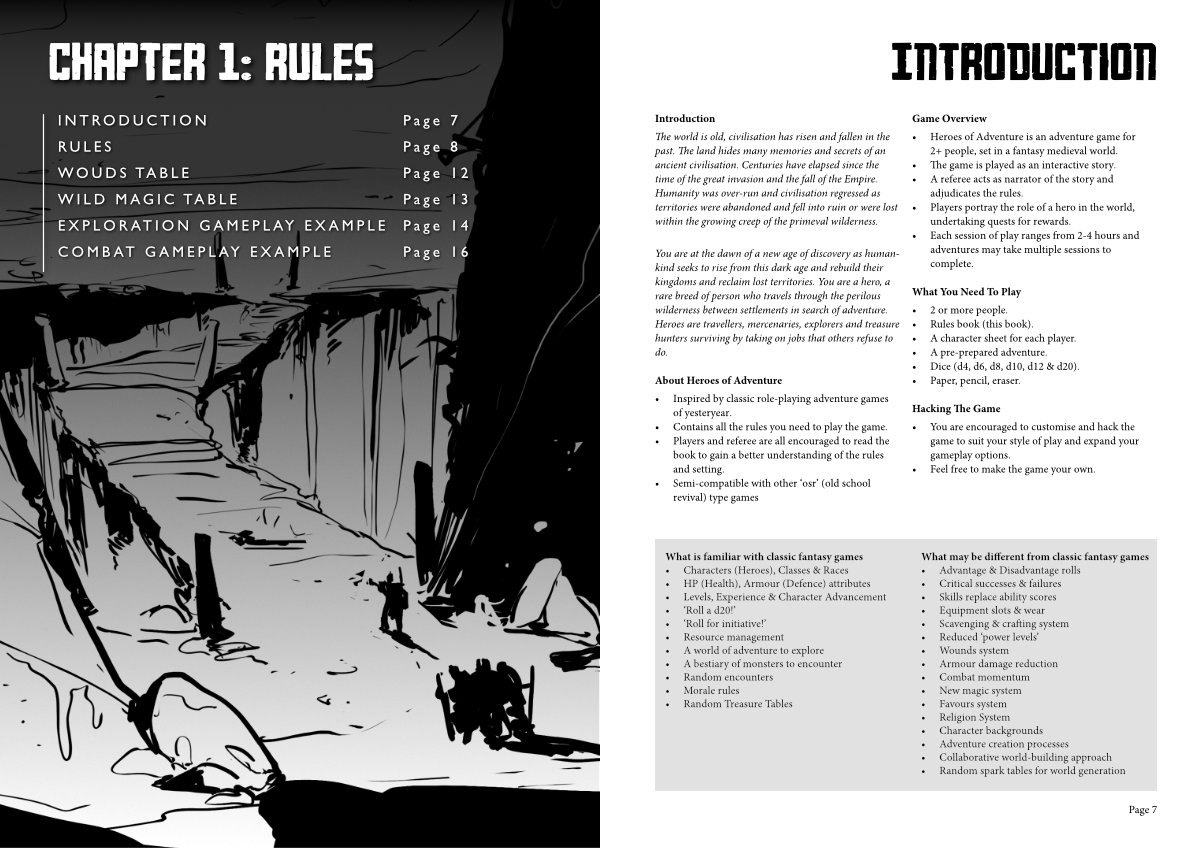
Chapter 1 – Rules
- These were originally a whole chapter but were subsequently condensed into 4 pages of a 190+ page book (the ‘rules summary’ actually became ‘the rules’)
- Classic adventure games of my youth had a weird mix of different dice rolls for different situations (i.e. d20, d00%, d6 etc) and this has been streamlined for ease of play.
- The core mechanic of the game is a d20 vs. target number system (roll equal to or above to succeed) with the target number being linked to a descriptive term (i.e. easy = 5, moderate = 10 etc). This creates a common language for players and referee to use and follows an intuitive; high roll is good; low roll is bad scenario.
- The game also uses a ‘d20 Reaction Table’ where; high roll is a good outcome and low roll is a bad outcome and this can be applied to many situations (monsters’ reactions, random events, the weather outlook etc).
- The referee could run the entire game just using the target number table and reaction table.
- Bonuses (+1, +2) to die rolls have not been included which reduces the complexity of remembering each of these and when to apply them
- A skill die modifier ranging from 0 (untrained) through to d4, d6, d8, d10, d12 or d20 representing different levels of threat or expertise. Dice rolling involves d20 plus a skill die and adding them up to equal or exceed a target number.
- The advantage/disadvantage rule (roll twice take the highest or lowest) has also been used as it is simple and elegant. This rewards players who have used smart play and innovative thinking and gives them a mechanical benefit they can use.
- Critical successes (natural 20) and critical failures (natural 1) have also been included. However, they can also be achieved through beating (or failing) a target number by 10 or more so highly skilled characters have a greater chance of critical successes.
- The core rules and wounds & wild magic tables have been turned into a separate .pdf document which acts as your rules reference at the table.

Chapter 2 – Setting
- The objective was to create a blank canvas that allowed the players and referee to collaboratively build their own world through gameplay and adventures (plus writing pages of lore is not my forte and does not guarantee any interest).
- ‘Just enough’ information has been provided to give the players a reference point and framework covering the general setting, regions, factions and broad history.
- As information, locations and adventures were discovered these can be plotted on the ‘world map’ or on more detailed ‘region maps.
- I was keen to promote an ‘on the table’ approach where these details are shared and used between players and referee and the setting was developed collaboratively through play with ‘The Fallen Lands’ setting becoming unique to each individual group.
- The map of the Fallen Lands setting has also been turned into a separate pdf players can print off and populate themselves.
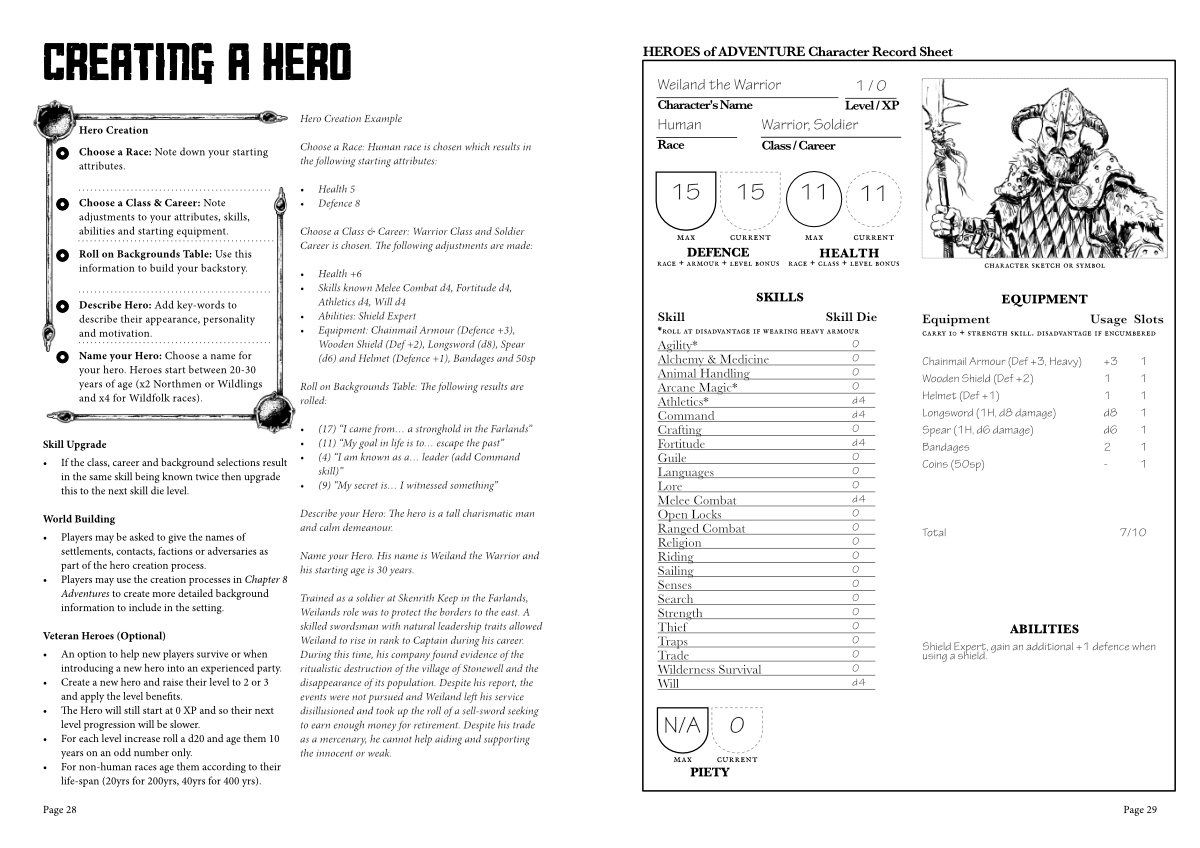
Chapter 3 – Heroes
- There were a number of touchstone points from classic fantasy adventure games that I wanted to retain (i.e. races, classes and levels).
- I also wanted character creation to be quick and easy to people could get up and running quickly and you develop your character through gameplay; hero creation takes 5-10 minutes.
- A potential controversial decision was not to include the classic 6 attribute (3-18 range) ability scores. I started with using attributes with a bonus score (i.e. strength +1) but eventually merged this with the skill system which gave players a skill die bonus (d4, d6, d8 etc) representing their skill in a different discipline (strength, agility, arcane magic, melee combat, opening locks etc).
- Personally, I like to more grounded medieval setting with some fantasy or weird elements which resulted in humans being considered the dominant species.
- Non-human races such as the Wildfolk (descendants of the Elves), Wildlings (Half-Elves) and Northmen (descendants of the Dwarves) exist but were thematically renamed and it is also suggested that they first be discovered (unlocked) during the game before they are used and even then make a limited appearance to make the character feel a bit more special when you use a non-human race.
- One variation I included is making non-human races earn more XP to progress than human races. The idea was humans were considered short ‘bright sparks’ in history (faster levelling, shorter life) whilst long lived races are ‘burning embers’ and accumulate knowledge over a greater period time (slower levelling, longer life).
- There are a 8 typical classes (Barbarian, Cleric, Druid, Knight, Mage, Ranger, Rogue and Warrior) each of which has four starting career options which affects starting skills, equipment, background and outlook.
- Character classes provide a simple way of defining your character and their role in the party but I wanted to avoid some of the traditional restrictions (i.e. why can’t my wizard wave a sword around). Class abilities (those special feats they can perform i.e. spells or combat abilities) are the unique elements of each class but the skills system is applied across all classes. Hopefully, this provides sufficient flexibility to develop a character the way you want.
- I wanted to include some type of background to link the character to the setting in some way and landed on the 4-question system which provided a mechanical link to the game (i.e. origin = home place on map; background goal = double XP opportunity; reputation = bonus skill and secret = plot hook).
- I have provided some sample heroes for immediate use but would like to recreate a whole batch of these in a small booklet (fond memories of owning and using the ‘Shady Dragon Inn’ book in the past).
- The character sheet pays homage to the B/X Dungeons & Dragons character sheet I first used many years ago and evokes that feeling of nostalgia.
- Experience Point (XP) awards and level advancement tables were another touchstone feature I wanted but they have been simplified and linked directly to in-game objectives.
- Around 50% of your XP will be earned through completing quest objectives (the key motivator) and the other 50% can be earned through exploration, encounters or finding treasure (the risk/reward element).
- Health score (equivalent of hit points) and damage ranges have all been limited to avoid ‘hit point bloat’ and a wide range of power levels. As characters increase levels the real benefit is their skill in doing more things better but survivability remains a concern.
- Level advancement benefits have been simplified and equalised across all classes although one restriction I included was the need to try a skill before you can improve it which leans into the ‘learn through failure and experience’ approach.
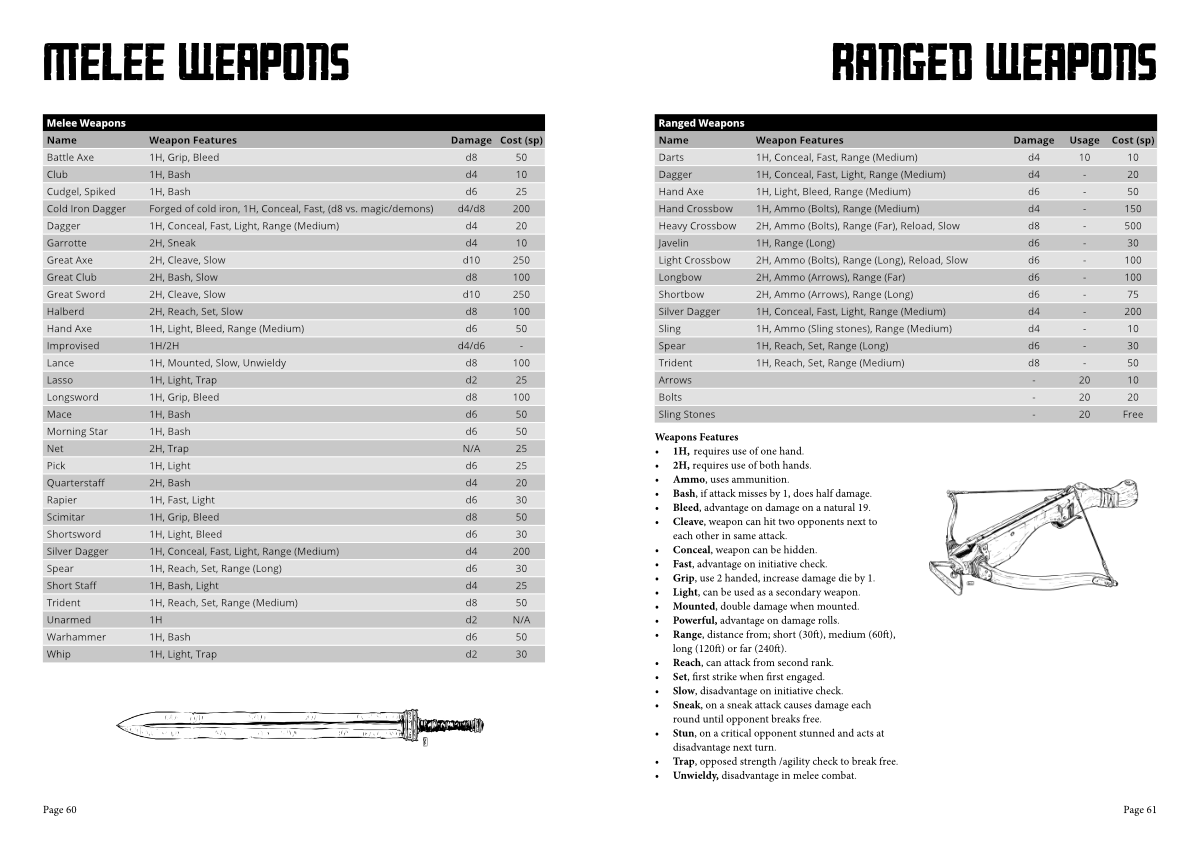
Chapter 4 – Equipment
- Equipment choice and resource management are features I wanted to include and the game uses a slot-based system for simplicity. Each character can carry 10 items +1 for each strength skill die (d4 = +1, d6 = +2).
- I wanted to add some tactical elements with weapon choice and avoid simply choosing a weapon with the biggest damage die. The ‘weapon features’ system grants benefit in some circumstances and gives players a tactical choice in game (i.e. a spear has a range benefit)
- Armour provides a bonus to defence but can also be used to absorb damage by sacrificing its defence protection (i.e. a shield offers +2 to your defence score but you can elect to absorb a hit in combat to take half damage but this reduces your shields protection to just +1 defence). The idea is armour and shields get damaged, dented, worn and may need repair and replacement. This also helps characters survivability but at a cost.
- I have used silver pieces as the default currency with gold more uncommon.
- I wanted to give the players lots of tools and equipment to play with so there is a ‘black-market’ section of uncommon items. This may include minor magics (i.e. charms, trinkets with a minor effect) or potions (created using components and considered a science).
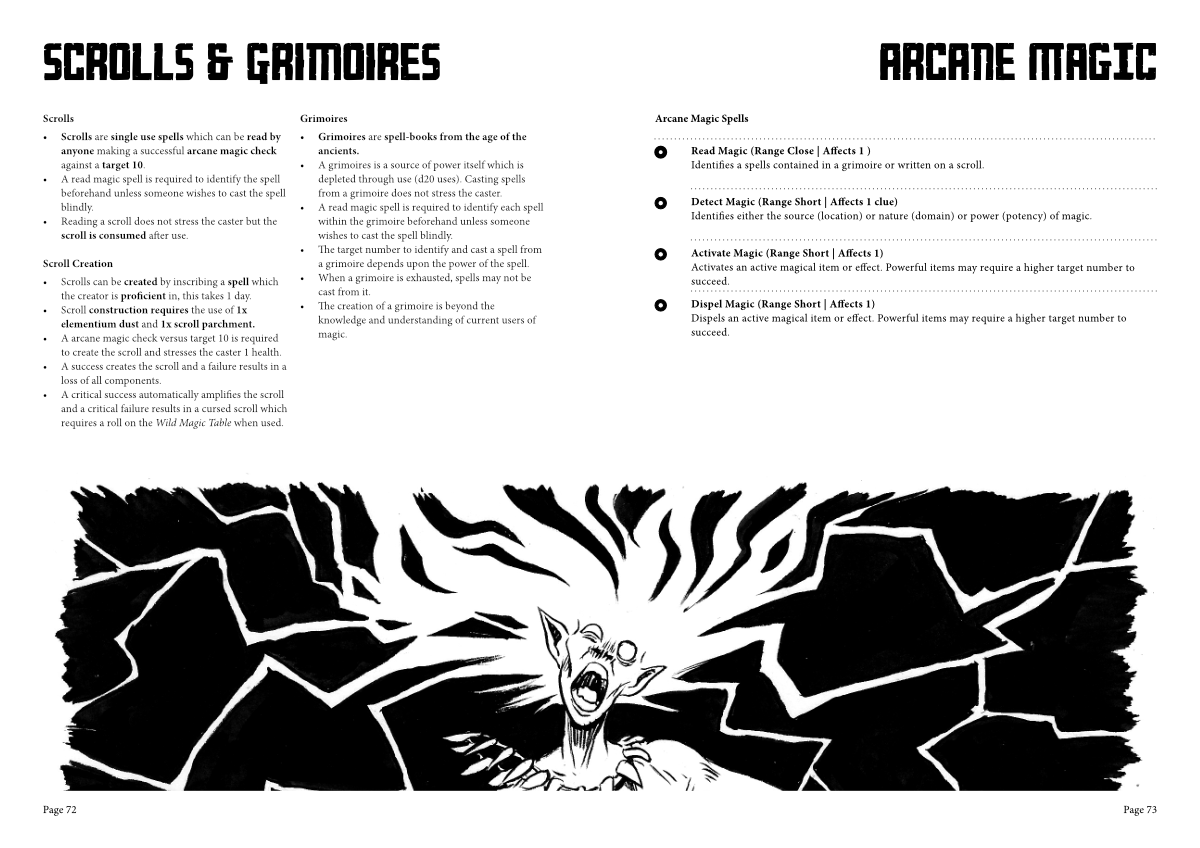
Chapter 5 – Magic
- Magic is described as a dangerous nebulous force aspected to different domains and is uncommon. I wanted a system where using magic was a force to be harnessed and a wildcard in its effect but the use comes at a risk and had to be used sparingly.
- Using magic stresses the caster resulting in a temporary loss of health points which can only be recovered through rest. This provides a nice easy way of capping spell use and makes a hero feel more fragile the more they use their power. Thematically, as magic use is uncommon then there should be some consideration and effect for public displays of magic (i.e. witchcraft)
- I developed a simple magic domain structure; spells are grouped under a thematic domain (fire, water, light, darkness). Having access to a spell domain grants access to each spell but the character would only be proficient in a couple of these and would gain more proficiencies as they gained more experience. Other spells could be used but would be cast at disadvantage creating a further risk/reward consideration.
- From a writing perspective, I was keen to avoid pages and pages of spell descriptions and individual rule and considerations so kept these short and simple.
- However, each spell has a degree of flexibility in terms of its impact and effect. Players have the choice to spend more health (the risk) to ‘amplify’ spell effects (the reward) if they wish.
- The danger of magic use is mechanically played out through the wild magic table, this may create a range of effects upon a critical failure.
- Miracles were a late addition to the rules. These were intended to be a greater spell granted to those users of magic who had mastered each spell in their domain. Miracles could have a major impact but the casting of these come at a substantial cost, a permanent reduction of your health score.
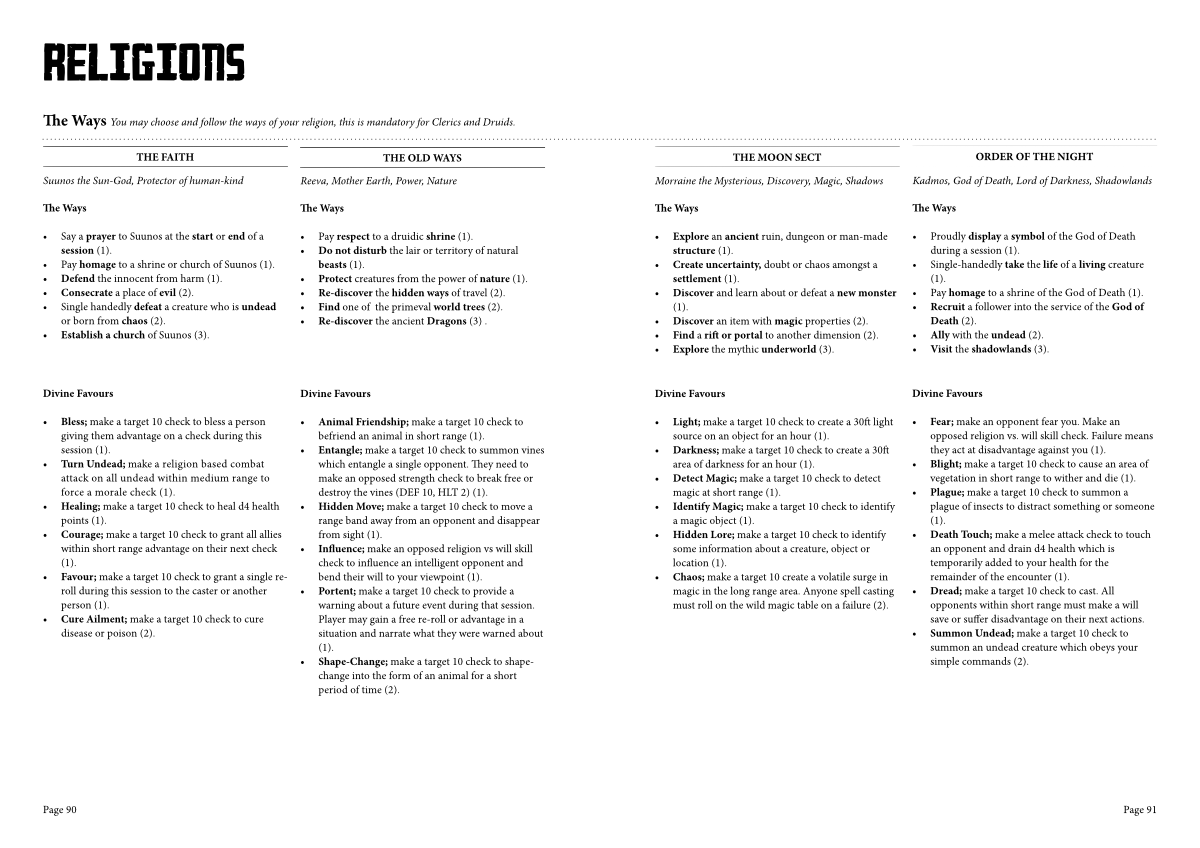
Chapter 6 – The Gods
- Traditionally, religion has been the focus for Clerics and Priests but I wanted religion to be something that was open to all heroes regardless of their class although this was mandatory for Clerics and Druids.
- Secondly, I wanted to provide some mechanical link between actions your character may take in favour of their religions to a bonus or benefit they could use. This also provides a simple way NPC Clerics and Priests can call upon minor divine favours.
- Therefore, if you agree to follow a God and the ‘ways’ of your religion then you earn piety points which can be spent on divine favours.
- 4 religions are provided but you are free to invite more or your own.
Chapter 7 – Crafting
- A key theme of the game is exploration and discovery. The concept of scavenging and crafting are two areas I wanted to lean into.
- Nothing lasts forever and equipment can deteriorate over time (a consequence of critical failures) and players are encouraged to find, adapt and use things you find in the game.
- The crafting aspect was designed to give the characters cool toys to play with based upon components they have discovered or acquired during their game. A character armed with a dagger coated with giant spider’s poison, a fire-resistant suit of chainmail and explosive dwarven munitions sounds much more interesting to play than a character armed with a dagger, chainmail and crossbow.
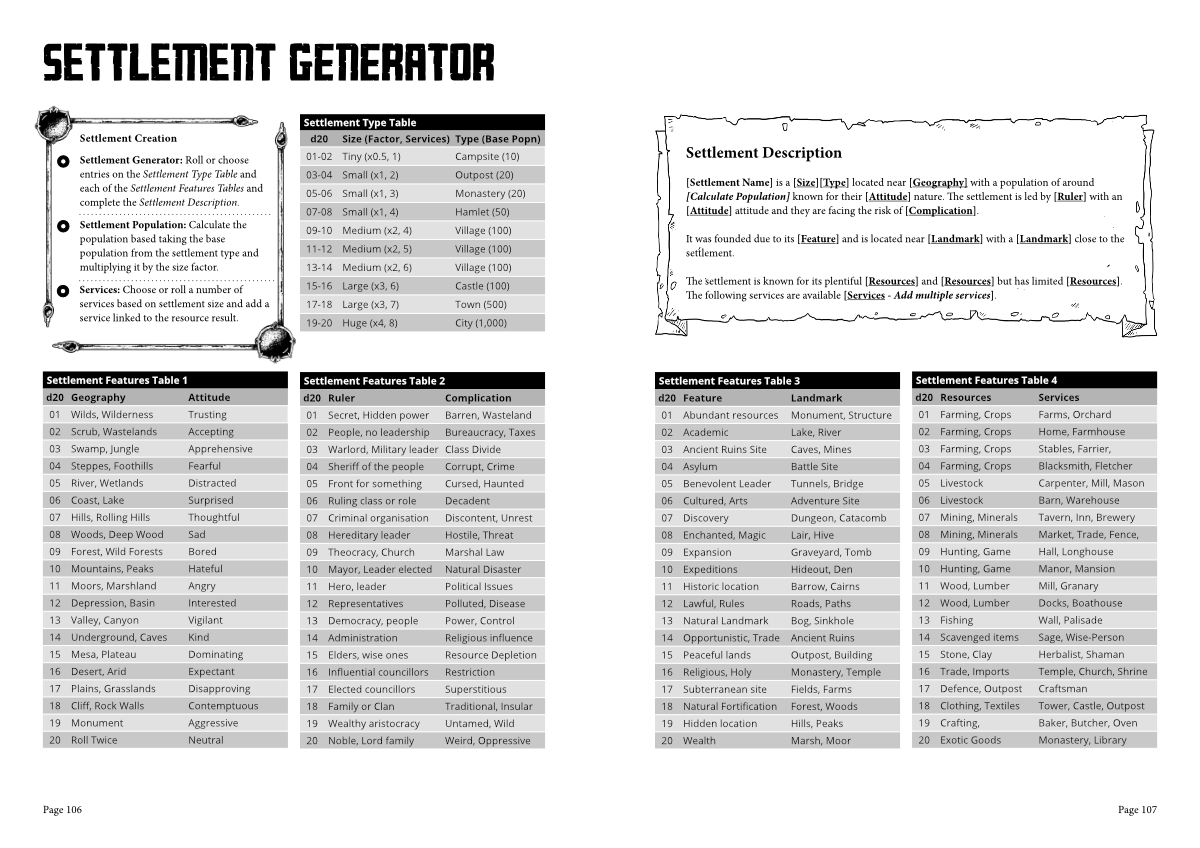
Chapter 8 – Adventures
- I wanted to write some simple procedures and tools to generate adventure content quickly and easily and give these tools a ‘mini-game’ feel where random dice rolls create outcomes or ideas you use in your setting.
- These tools can also be used by players to generate background related contents (i.e. settlements or NPCs) and provides another link to the concept of shared world-building.
- This chapter contains the following generators; region map; settlements; quests; adventure site; adventure map; treasure; monsters; NPCs; factions; challenges; artifacts, encounters and rumours and provided guidance on how to use these.

Chapter 9 – Refereeing
- This was originally the rules section of the game but the core mechanics were separated into the rules and this was left as more of a process and guidance chapter which you can read and refer back to but don’t have to follow during the game.
- The referee principles mirror the common ‘osr’ (old school revival) type approach which can be simply summarised as don’t be constrained by perceived rules and procedures just let the game flow and have fun.
- The shared world principle was designed to take away some of the ‘heavy lifting’ the referee has to do when preparing adventures and make this more of a collaborative process between players and referee by building the story together.
- The running the game section provides a simple process and reminder in terms of the steps to take before, during and after a session.
- There are several pages providing further guidance on; checks; survival, adventuring; wilderness travel encounters and combat.
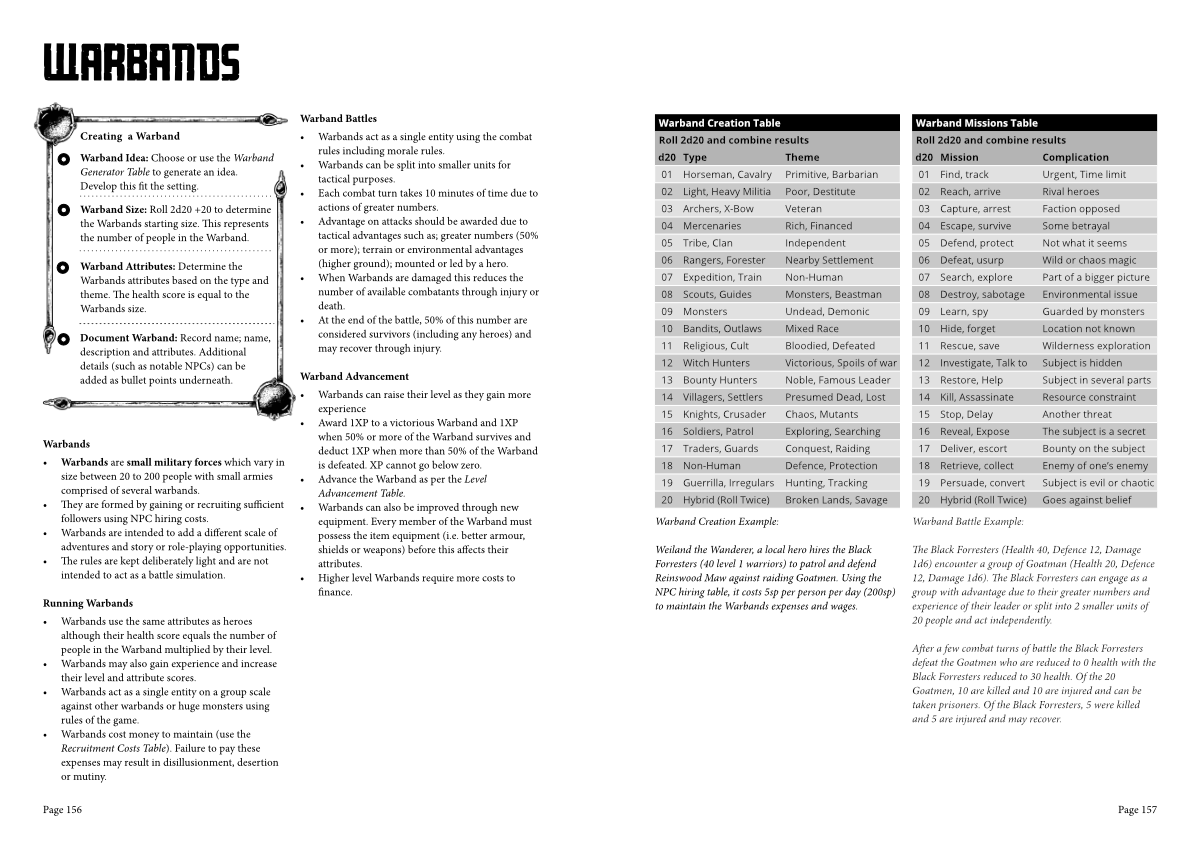
Chapter 10 – Campaigns
- The game was designed around an episodic structure of adventures taking between 3-5 sessions. This was based on a regular (virtual weekly sessions due to the pandemic) of about 2 hours so face to face sessions may be longer and session numbers shorter.
- However, (in a case of classic scope creep) some guidance has been provided on creating a campaign which can be summarised as ‘start small and build out from there'.
- One new tool is the concept of ‘plots’. This is simply a storyline broken into 3 phases each containing 3 events which provides a framework to progress through each step.
- The outcome of each adventure should influence how these events progress (i.e. stop, go, pause, change) and complexity can be developed when different factions have their own plots with events which may interact and cause tension.
- Whilst the theme of travelling adventures was a starting point, I have included some longer-term elements such as enterprises (investing in something); domains (settlement/land management) and warbands (larger groups).
- The primary purpose of these elements is to create a different scale of quests and adventures with the actual mechanics of running an enterprise, domain or warbands kept very simple and was earning income was a secondary concern.

Chapter 11 – Bestiary
- One of my fondest memories of my earliest role-playing games was when you first discovered a new monster. Its appearance and characteristics may be initially described (i.e. a nine foot long worm creature) and then our group had to think what it might be and how we might respond to it. We had no idea the creature was actually Carrion Crawler from Page B32 with 3+1 hit dice. Encounters were new, risky and exciting.
- I needed a catalogue of monsters to use, wanted some of those classic experiences but didn’t want people to be overly familiar with the bestiary and have therefore refreshed the bestiary and tweaked names, attributes and abilities for a fresh experience.
- Monsters have been categorised into groups (i.e. Plant, Beasts, Chaos, Undead etc) with a range from low to high levels of power or threat.
- Stat blocks operate in the same manner as heroes and NPCs. Ability tags (i.e. keywords) have been used which the referee can interpret and decide their mechanical use to save writing unnecessary specific details.
- I have also included some monsters tactics and lore into the descriptions to provide the referee with some support in terms of using the monsters during an encounter.
Appendices
- I have included the following templates; character sheet; blank hex map (region); blank grid map (adventures); adventure session tracker; npc template and monster template. Each of these will be available as separate downloadable pdfs.
Get Heroes of Adventure
Heroes of Adventure
Index of Heroes of Adventure releases and community forum
| Status | Released |
| Category | Physical game |
| Author | Nameless Designer |
| Genre | Role Playing |
| Tags | dungeons--dragons, Fantasy, OSR, Tabletop role-playing game |
More posts
- Oct 22 - Heroes of Adventure Game Jam (Dec 22)Oct 21, 2022
- Oct 22 - Heroes of Adventure version 1.0 releaseOct 15, 2022
- Jul 22 - Referee's Guide ReleaseJul 23, 2022
- Jul 22 - Referee's Guide UpdateJul 04, 2022
- Jun 22 - Heroes of Adventure Players Handbook UpdateJun 24, 2022
- Feb 22 - New Adventure, Game Balancing & Version 0.2Feb 06, 2022
- Dec 21 - Release!Dec 22, 2021
- Dec 21 - Final PlaytestDec 22, 2021
- Dec 21 - Development LogDec 16, 2021
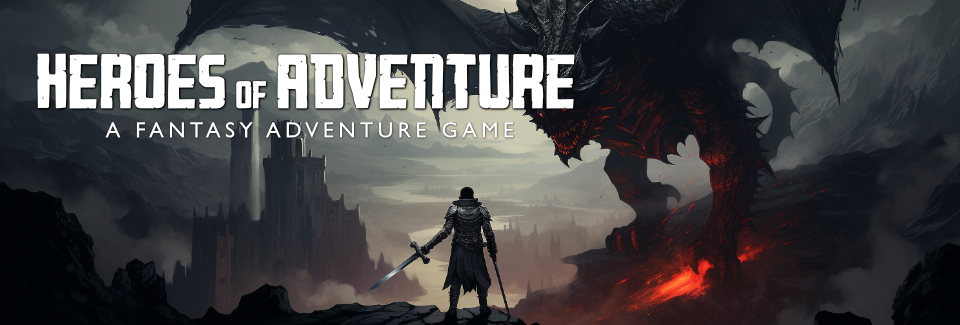
Leave a comment
Log in with itch.io to leave a comment.